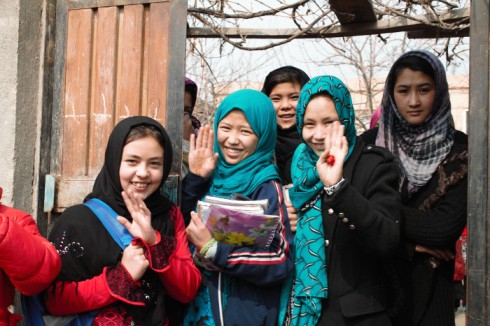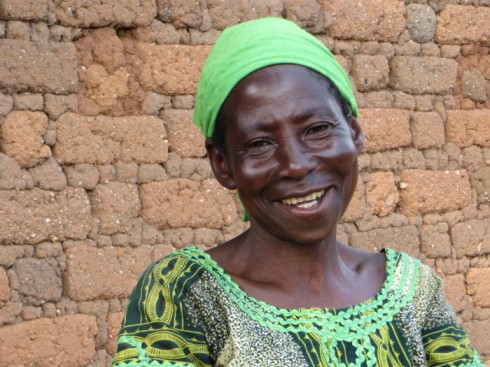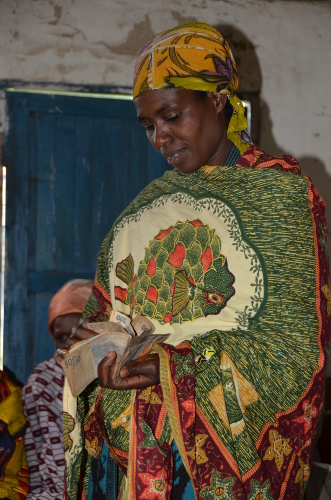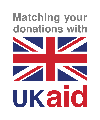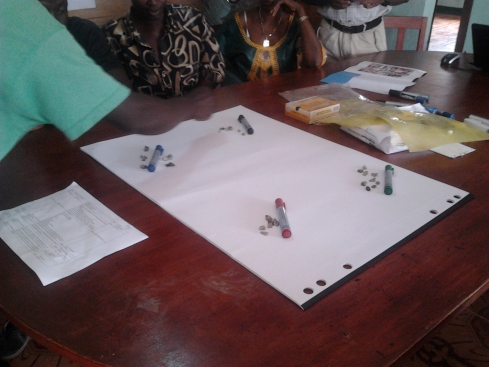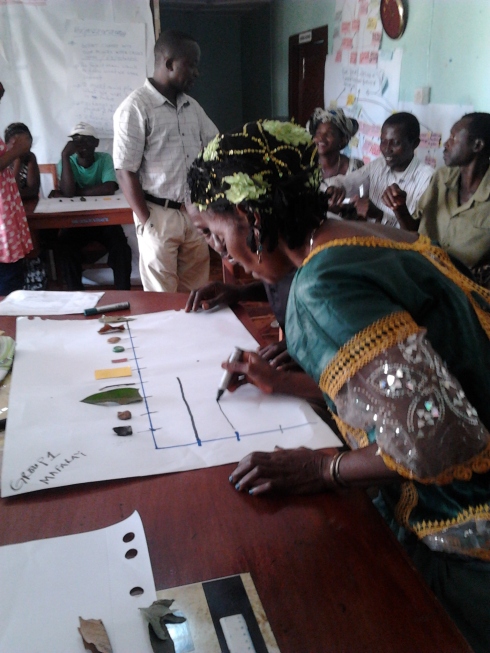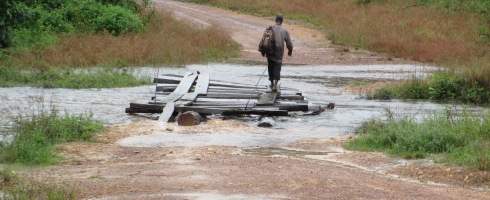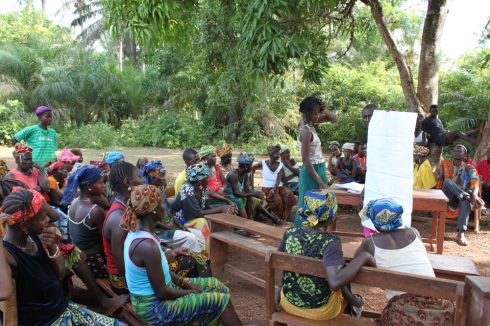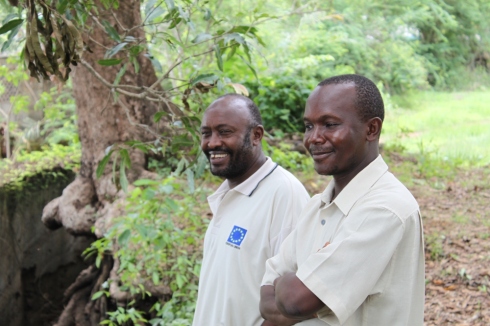“when we reached the community people just threw up their hands and thanked God that we found them, thanking us over and over for coming so far, where nobody else had come before, to help them”
Having recently joined Children in Crisis as the new Programme Manager for Liberia, I was excited to visit our programmes in Liberia and get to know our local implementing partners, FAWE Liberia. As I have only just returned from two years in Liberia with another large International NGO, I was very interested to see how Children in Crisis and FAWE fare in comparison – and I have to say, I was impressed. Not only are Children in Crisis and FAWE delivering world-class programming for children – we are also practicing what we preach – reaching the most remote and hardest to reach communities.
After arriving on Sunday evening in Liberia’s capital, Monrovia, on Monday morning we set straight off to River Cess – the county where Children in Crisis and FAWE are working. River Cess is a remote county in Liberia’s south eastern region – a region which is widely recognised as an area of huge need, but which is also notoriously remote and hard to reach, so that few NGOs venture there (Children in Crisis and FAWE are currently the only NGOs delivering teacher training in River Cess, and the Children in Crisis/FAWE Vocational Training Centre is the only vocational training institute in the entire county providing skills training and adult literacy for vulnerable women).
The road conditions travelling to River Cess were incredible – a slalom of red mud, rain and river crossings, making it a perilous journey only passable because of the skill and courage of the FAWE driver, and the powerful new four-wheel-drive vehicle we were lucky enough to procure thanks to generous donor support.
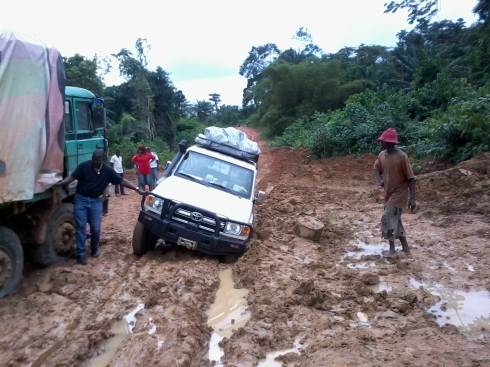
The Children in Crisis and FAWE vehicle gets stuck in the mud on the road between Monrovia and River Cess, trying to pass a truck which has been stuck in the mud for days. The team had to winch the vehicle out of the mud – this is a frequent occurrence whenever travelling to River Cess.
This is not something new for the team here – with such difficult road conditions, particularly during Liberia’s heavy rainy season from April to October each year, the Children in Crisis and FAWE vehicle regularly gets ‘hitched’ in the mud, as Liberians say! However, this is only the beginning. Once the team reach Cestos City, the capital of River Cess County (which is more like a small village than a ‘city’!), they have a much longer journey ahead, and one where the trusty 4-wheel drive can’t go. From there, they brave the motorbikes in pairs – and on these roads, it’s not for the faint hearted!
The FAWE Teacher Trainers regaled me with stories of slipping and sliding their way through narrow jungle pathways, or hauling their motorbikes over their heads to wade through rivers waist deep which intercept the thick jungle pathways. And then there is always that inevitable point where the ‘bush’ (the jungle) gets so thick even the motorbike can’t get through, and our FAWE colleagues continue on foot – often for up to 4-5 hours, and with numerous perilous river crossings along the way, forcing the team to wade through shallow waters, travel in dug-out canoes, or cross tentative bridges made of single tree trunks on their hands and knees because there was nothing to hold on to. The River really is boss in River Cess, as the name implies.
The Cestos River and its many tributaries branch across the county, paying little heed to roads or bridges in its path (or houses and schools, for that matter!). But FAWE have been working in River Cess for years, and the team know the terrain, and are familiar with the determination of the River – but their determination is even greater, and it’s truly inspiring to see the lengths they go to, to reach these remote communities.
So many of the communities we are working in are so remote and so far from the road, no NGO has ever ventured there before, let alone Liberia’s under-resourced government – during a recent baseline assessment (which Children in Crisis and FAWE undertook to identify the most vulnerable schools to target for the project this year) one of the Children in Crisis/FAWE Teacher Trainers described how “when we reached the community people just threw up their hands and thanked God that we found them, thanking us over and over for coming so far, where nobody else had come before, to help them”. She quoted one community leader who told them “no NGO has ever reached us before. We are so happy. Thank you for finding us.”
So, why do we do it? Because Children in Crisis and FAWE believe that every child has the right to education, no matter where they are – we are committed to ensuring all children receive the education they need for their flourishing and wellbeing and to help transform their lives. Where resources are few, where education is needed to heal the nation, and where it is too remote for others, we are determined to support children to read, write, think, pursue their life goals and contribute positively to their communities and their countries – and this means ALL children, not just those who are easy to reach.
Gallery of photos (click to enlarge and browse):
-
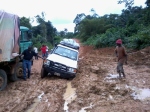
-
The Children in Crisis and FAWE vehicle gets stuck in the mud on the road between Monrovia and River Cess, trying to pass a truck which has been stuck in the mud for days. The team had to winch the vehicle out of the mud – this is a frequent occurrence whenever travelling to River Cess.
-
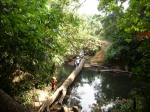
-
Teacher trainers balance their way along a log-bridge on their way to conduct PTA Training.
-
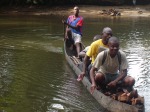
-
Teacher trainers Plaka and Jarvis, and Education Manager Rufus, cross a river in Zolay town by canoe to reach a community cut-off by water to provide coaching to trained teachers.
-
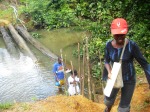
-
Teacher Trainers, Cora and Satta, wade across one of the more accessible river crossings on foot to conduct observation visits to teachers in remote schools who have been trained by FAWE.
-
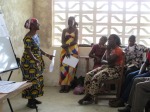
-
Martha J Waye – small in frame, but big in passion and determination – who walked for 4 hours and travelled for another 2 hours by canoe to reach the PTA training.
-
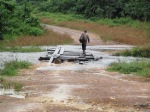
-
Principal Kofa Nagbe from Boboe Public School.
We also do it because equitable access to quality education and development opportunities is essential for maintaining Liberia’s peace. The brutal civil war, which tore Liberia apart between 1989 and 2003, was triggered by the frustration caused by the stark inequality between the few who ‘had’ and the vast majority who ‘had not’, and widespread poverty and exclusion in Liberia’s most remote rural areas left thousands of people (particularly disenfranchised young men) frustrated and vulnerable to being mobilised by warlords and militia groups. This is just one of the many reasons why it’s so important that Liberia’s post-conflict transition and recovery includes development for all, not just development for those who are easier to reach – not just to ensure Liberia’s growth and development, but also for lasting peace.
But doesn’t reaching the most remote mean spending more time, energy and resources, I hear you ask? Well, it’s not so much a question of how much you invest, as a question of what return you get from that investment, and I’ve seen first-hand that when you go the extra mile (quite literally!) to reach the hardest to reach, you get that effort back tenfold from the communities.
For example, while in Liberia, I was lucky enough to observe our fantastic Teacher Trainers in action during some Parent Teacher Association (PTA) training. Children in Crisis and FAWE are not just committed to improving access to and quality of education through training teachers and school administrators, building and rehabilitating schools and distributing school materials – we’re also committed to empowering and mobilising communities via PTAs to take their children’s education into their own hands to inspire lasting, sustainable change – this PTA training helps to equip PTAs with the knowledge and skills they need to do this. During the training, I witnessed first-hand the commitment and dedication of the parents and teachers in the remote communities where we work to grab this development opportunity with both hands and make life better for their children. Like our FAWE colleagues, they too are determined, no matter how long and perilous the journey they have to take to get there (to minimise the distance participants have to travel, make the most of limited resources, and so PTA members can learn together and share their experiences, we cluster the training into groups of communities, to get as close as possible to the schools, but with such sparse and remote communities, this still means a long journey for most).
Martha J Waye is a Parent-Teacher Association (PTA) member from Yarnee District in River Cess. She is pictured here, presenting group-work back to her fellow participants at the recent Children in Crisis/FAWE PTA training in Cestos, River Cess, in September 2012. She walked for 4 hours and crossed the Cestos River for another 2 hours in a dug-out canoe to reach the training, but she was delighted to be there – Martha told us how happy she was to be part of the training, and how she would have walked even further to be there, because she is so happy that now she knows how to be a good PTA member and how to make the school better for children. She said she would carry all the good lessons back to her school and do everything the trainers taught her. She thanked FAWE and Children in Crisis for everything they are doing for her community, and for not forgetting their community because they are too far.

Martha J Waye – small in frame, but big in passion and determination – who walked for 4 hours and travelled for another 2 hours by canoe to reach the PTA training.
Children in Crisis and FAWE work hard to reach the furthest and most remote communities, who are often forgotten and miss out on basic services like education, but when we get there, the passion and commitment of community members like Martha make the journey worth every step. Their determination, passion and commitment to make the most of every training opportunity or resource provided and work tirelessly to improve their children’s education means that any investment we make is magnified and has a massive impact of the most vulnerable children. So, even if the investment of time, effort and resource we have to make is slightly higher to reach the hardest to reach, the return on that investment is so huge, and the impact on children so great, it’s worth it.
I will leave you with a single image of Principal Kofa Nagbe from Boboe Public School (he was trained by Children in Crisis & FAWE in 2011), who we met along the road one day on our way to Logan Town School. Unfortunately, we reached a point where the bridge was impassable (a heavy-duty log-bridge had been transformed into a raft-like structure, barely clinging to the banks of the swollen river below), so we had to bid farewell to Principal Nagbe, who has a long journey ahead on foot, through rivers and jungle, to reach his school and community. But he won’t give up – he will keep walking, no matter how far and no matter what the weather, because like so many of the teachers, community members and children we work with, they are determined to rebuild their lives and look forward to a brighter future.
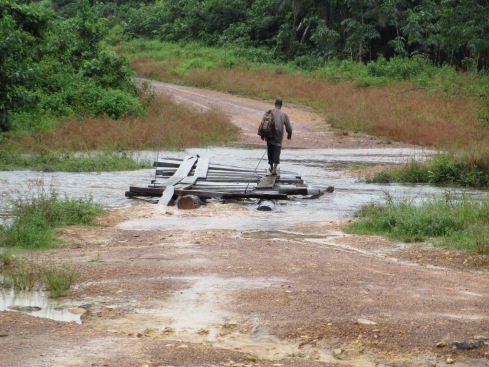
I left Liberia feeling incredibly proud to work for Children in Crisis and in partnership with FAWE. It is truly inspiring to see the lengths the team are willing to go to reach the hardest to reach, and even more inspiring still to see how far communities are willing to go to improve education for their children. With such passion and determination among Liberians, whether beneficiary communities or our dedicated local partner colleagues, I have no doubt that Liberia will recover and re-build, even if it is a long road ahead…
Tags: Cess County, Cestos, charity, children, children in crisis, classrooms, communities, community, development, education, FAWE, Liberia, NGO, not for profit, parent, partnership, poverty, PTA, River Cess, schools, teacher, teacher training


